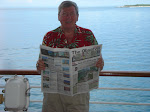 |
| Our plane getting some new NAV/COM's |
 |
| basic instruments, plus Weatherscope (square upper right) |
We're replacing the upper left hand gauge which is actually a clock that performs other functions during instrument flight. My son told me I shouldn't worry myself about what is going on, since I'm destined to be a VFR pilot forever, provided I get that far (ha ha). When we purchased the plane, we knew we'd have to make some improvements, so now the dance has begun.
I've included a picture of what her instrument panel looked like last Monday morning. When we get her back, it will look a bit different although the changes won't be all that apparent to the uneducated. I may be the poster boy for the uneducated, mind you.
What we do know is that the plane will now have TWO working radios, allowing me to pre-set four different frequencies for ATIS (weather conditions), Ground (to taxi), Tower (to take off) and Tampa approach and departure (once I'm airborne). We've had contact with the avionics shop, which is installing a Garmin 650 Nav/Com. There were two radios (4 potential channels) in the plane, but we learned that the prior owner switched them, thus disabling a perfectly good glide slope indicator. Faceplates were replaced on one of the radio's, the other had issues therefore we couldn't easily set them to different stations. The "good" radio stays, and the 650 Garmin becomes the primary as a Nav/Com includes both Navigation AND Communications. The stack will appear different, on the right side. The basic "six pack" will remain on the left.
So, while the aircraft was manufactured in 2001, new instruments were installed in 2008, which included a KX155A Nav/Com, which will be replaced with the Garmin "touch screen" 650, and a second KX155A with Glide Slope, which stays. Once installed, the confusion between the actual NAV unit and the glideslope indicator will get sorted out. Sort of a 1=A and 2=B, instead of the current 1B, 2A setup. The Garmin GTN (Garmin Touchscreen Navigation) 650 will offer a visual display will make it possible for my son to get his entire instrument training in our own plane. That's a significant savings from having to use the school's aircraft with the Garmin 1000, which costs $150 an hour to rent. What I like is the redundancy - two separate radios, independent of each other, and two glideslopes. Shucks, even I might be able to operate with this stuff, and of course the autopilot.
The autopilot (as shown below) is really nifty - you simply set the heading "bug" to where you want to go, and flip it on - and Otto flies to that heading. He also makes better banking turns than do I. The other autopilot is 36, and calls me "Dad", when not calling me an immature teenager masquerading as a respectable sixty something. I admit to a certain boldness, but only in the Corvette. While there are Old Pilots, and there are Bold Pilots, there are very few Old, Bold Pilots.






